Bali Car Rental Hyundai Stargazer For Your Family Trip In Bali

Taking your family on a trip to Bali is something many people dream of, but if you know how to drive, you should consider the cost difference between driving yourself and hiring a driver. Driving yourself can help you stay within your budget, especially if you plan to stay for more than a week, as it can be more convenient than calling a taxi. With Bali self-drive car rental, you will have more flexibility and efficiency.
Choosing a 7-seater car like the Hyundai Stargazer with automatic transmission will be very comfortable, making your road trip in Bali more memorable and unforgettable.
Consider renting from Balisakti Bali Car Rental, a reliable company with extensive experience in providing car rental services. Safety is our top priority, and our cars are well-maintained and include insurance. Our goal is to meet all your transportation needs during your visit to Bali. We also offer free delivery and pick-up at the airport.
What can you visit when you rent self drive car rental in Bali
There are many places you can visit with your self-drive car rental in Bali. Bali is renowned for its beautiful tropical forests, beaches, lakes, and mountains, offering a variety of stunning destinations to explore.
We will help you create your own destination list in Bali. With this guide, you will have a clear idea of what to do and where to go when visiting Bali on your own.
Melasti Beach
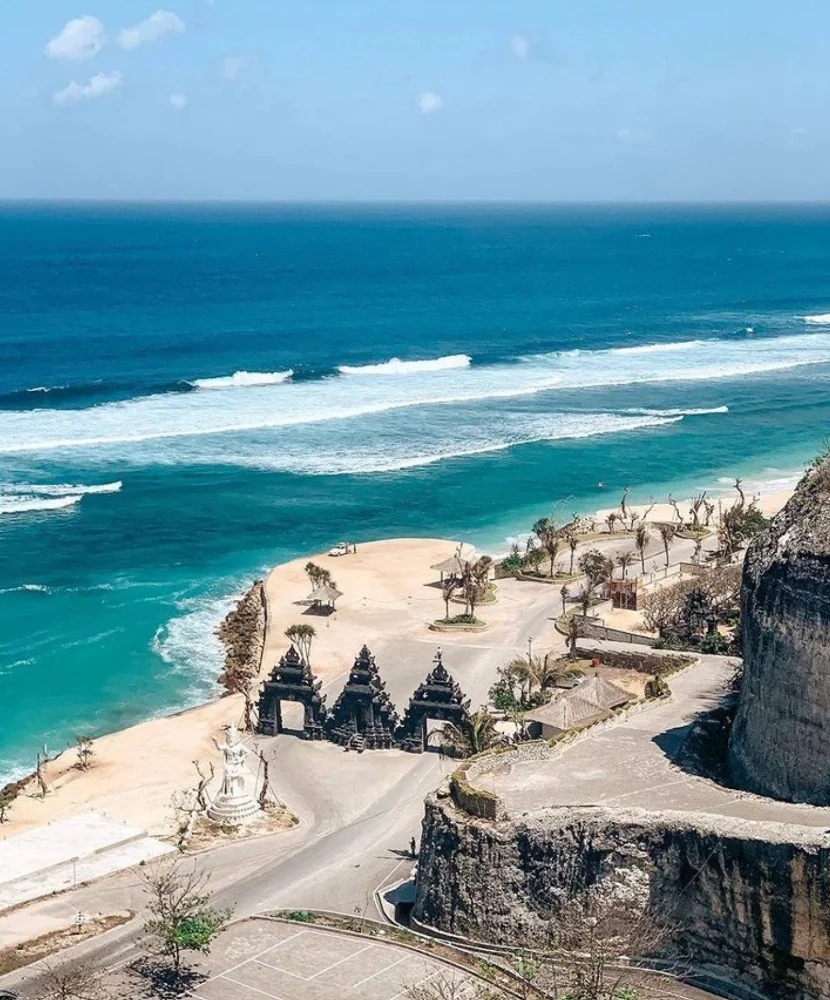
Melasti Beach, located in the Ungasan region of Bali’s Bukit Peninsula, is a stunning and relatively secluded destination known for its pristine white sand, dramatic limestone cliffs, and crystal-clear turquoise waters. Here are some highlights and features of Melasti Beach:
- Scenic Beauty: The beach is renowned for its breathtaking landscapes. The limestone cliffs that line the beach create a dramatic backdrop, making it a perfect spot for photography.
- Clear Waters: The waters at Melasti Beach are exceptionally clear, making it an excellent spot for swimming and snorkeling. The beach’s gentle waves also make it a great location for families with children.
- Tidal Pools: During low tide, natural tidal pools form along the beach, providing a unique opportunity for visitors to explore marine life in a safe and accessible manner.
- Sunsets: Melasti Beach is a fantastic place to watch the sunset. The combination of the setting sun, the cliffs, and the ocean creates a magical atmosphere that is both relaxing and awe-inspiring.
- Access and Facilities: The beach has become more accessible in recent years, thanks to improved infrastructure. There are also several local warungs (small eateries) and facilities where visitors can enjoy refreshments and rent beach chairs.
- Cultural Significance: Melasti Beach holds cultural importance for the local Balinese people. It is often used for Melasti ceremonies, a purification ritual that takes place before the Balinese New Year (Nyepi). During these times, visitors can witness traditional processions and rituals, offering a glimpse into Balinese culture.
Melasti Beach is a must-visit destination for those seeking a blend of natural beauty and cultural experiences in Bali.
Nusadua Beach Water Blow
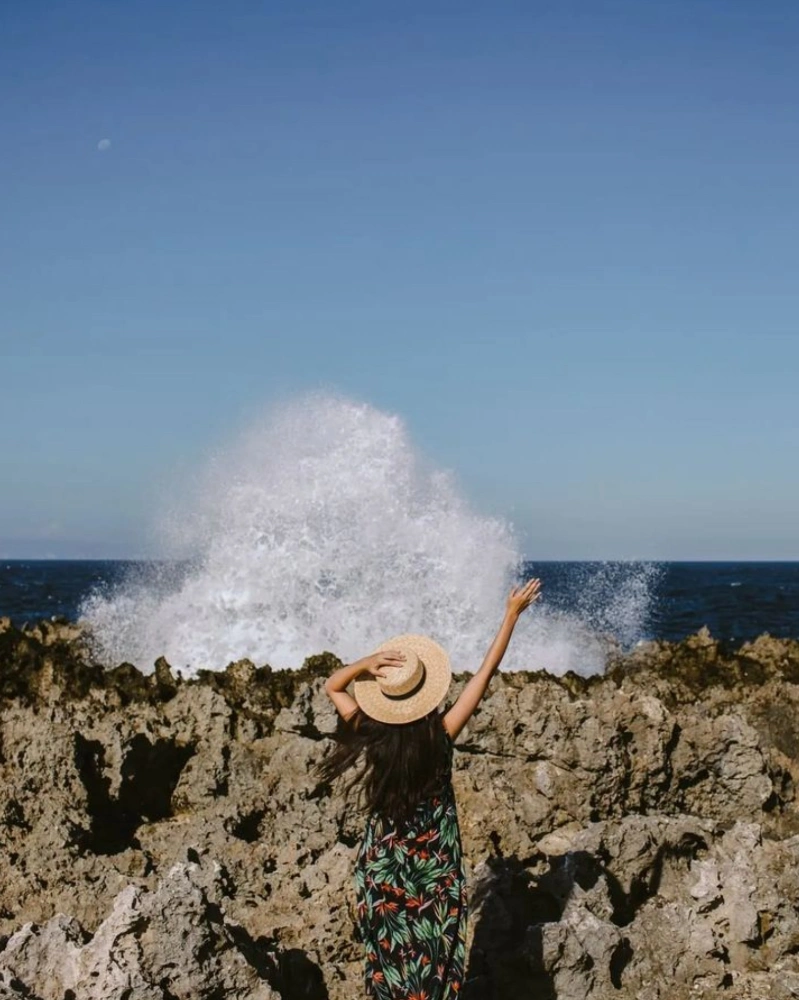
Nusa Dua Beach Water Blow is a popular natural attraction located in Nusa Dua, on the southeastern coast of Bali, Indonesia. This site is known for its dramatic ocean waves that crash against the rocky cliffs, creating impressive sprays of water that can reach several meters high. Here are some key points about Nusa Dua Beach Water Blow:
- Location and Access: The Water Blow is situated within the ITDC (Indonesia Tourism Development Corporation) complex in Nusa Dua. It is easily accessible from major resorts and hotels in the area. The site is marked with clear signage, and there is a designated walkway leading to the viewing platforms.
- Natural Phenomenon: The Water Blow occurs due to waves from the Indian Ocean striking a narrow gap in the limestone cliffs. The force of the waves creates spectacular bursts of water, especially during high tide and rough seas.
- Best Time to Visit: The best time to witness the Water Blow is during high tide when the waves are at their strongest. It is recommended to check the tide schedules to plan your visit accordingly. Early mornings and late afternoons are popular times due to favorable light conditions for photography.
- Safety Considerations: While the Water Blow is a breathtaking sight, it can be dangerous. Visitors are advised to maintain a safe distance from the edge of the cliffs and adhere to posted warning signs. The force of the waves can be unpredictable, and the area can become slippery.
- Facilities and Amenities: The area around the Water Blow is equipped with walkways, viewing platforms, and seating areas. There are also nearby facilities such as restrooms and parking spaces. Additionally, the ITDC complex offers various dining and shopping options.
- Surrounding Attractions: Nusa Dua itself is known for its beautiful beaches, luxury resorts, and golf courses. Nearby attractions include the Bali Collection shopping center, Pasifika Museum, and several high-end spas.
Nusa Dua Beach Water Blow is a must-visit for nature enthusiasts and photographers looking to capture the raw power of the ocean in a picturesque setting.
Uluwatu temple
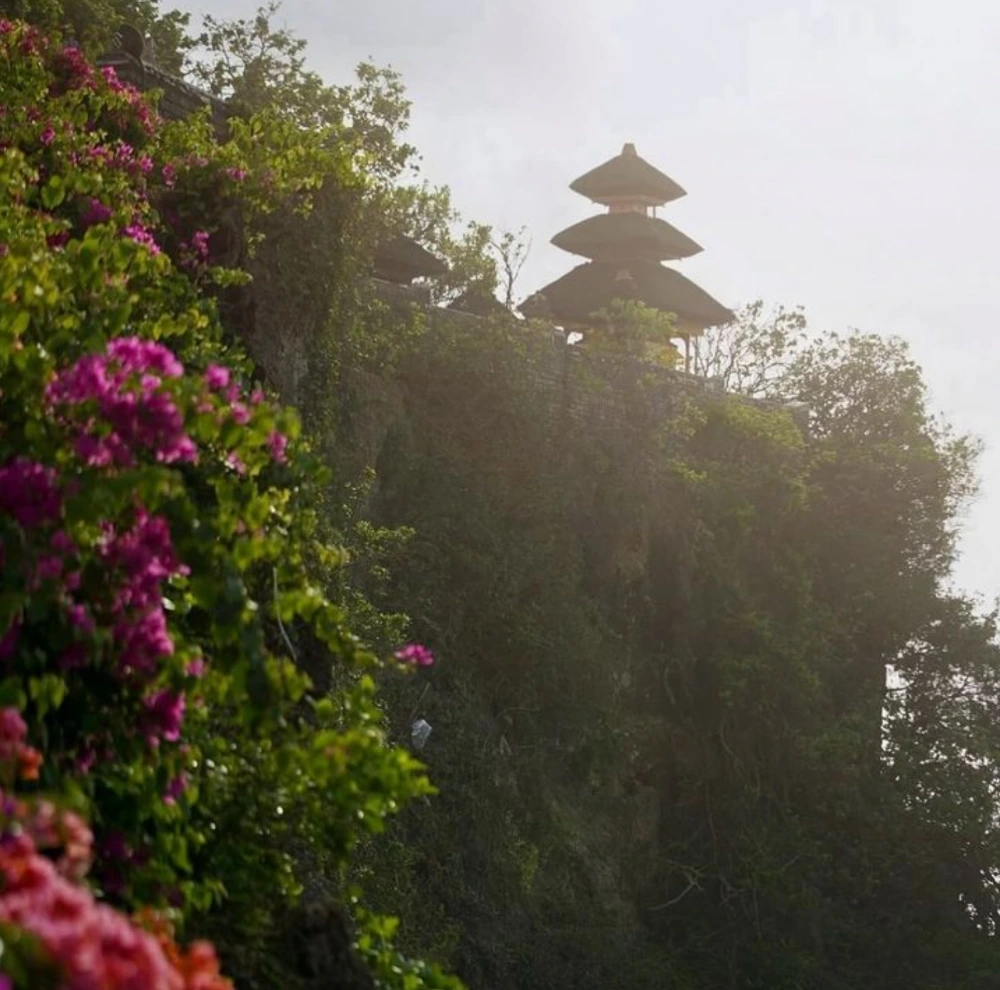
Uluwatu Temple, or Pura Luhur Uluwatu, is one of Bali’s most famous sea temples, known for its stunning cliffside location and cultural significance. Here are the key points about Uluwatu Temple:
- Location and Setting: Uluwatu Temple is perched on a steep cliff approximately 70 meters above the Indian Ocean on the southwestern tip of the Bukit Peninsula in Bali, Indonesia. Its dramatic setting offers breathtaking views of the ocean, especially during sunset.
- Historical and Cultural Significance: Uluwatu Temple is one of the six key directional temples in Bali believed to protect the island from evil spirits. It is dedicated to Sang Hyang Widhi Wasa in his manifestation as Rudra, the god of the elements and cosmic forces. The temple is an important site for Balinese Hindus and plays a significant role in local religious practices.
- Architecture: The temple features traditional Balinese architecture with intricately carved gateways, stone statues, and well-maintained gardens. Its cliffside location and the design elements reflect the Balinese belief in harmony with nature.
- Kecak Dance Performances: One of the highlights of visiting Uluwatu Temple is the Kecak dance performance held daily at sunset. This traditional Balinese dance, accompanied by a choir of male chanters, depicts a scene from the Ramayana epic. The performance takes place in an open-air amphitheater with the ocean and setting sun as the backdrop, creating a magical atmosphere.
- Visiting Tips:
- Dress Code: Visitors are required to wear a sarong and sash, which are provided at the entrance, as a sign of respect.
- Monkeys: The temple is home to a large population of monkeys known for their cheeky behavior. Visitors should keep a close watch on their belongings as the monkeys are known to snatch loose items such as sunglasses, hats, and cameras.
- Best Time to Visit: Late afternoon is the best time to visit to enjoy the sunset and the Kecak dance. Arriving early ensures you have enough time to explore the temple grounds before the performance.
Uluwatu Temple offers a unique combination of natural beauty, cultural richness, and spiritual significance, making it a must-visit destination for those exploring Bali.
Tanah Lot Temple
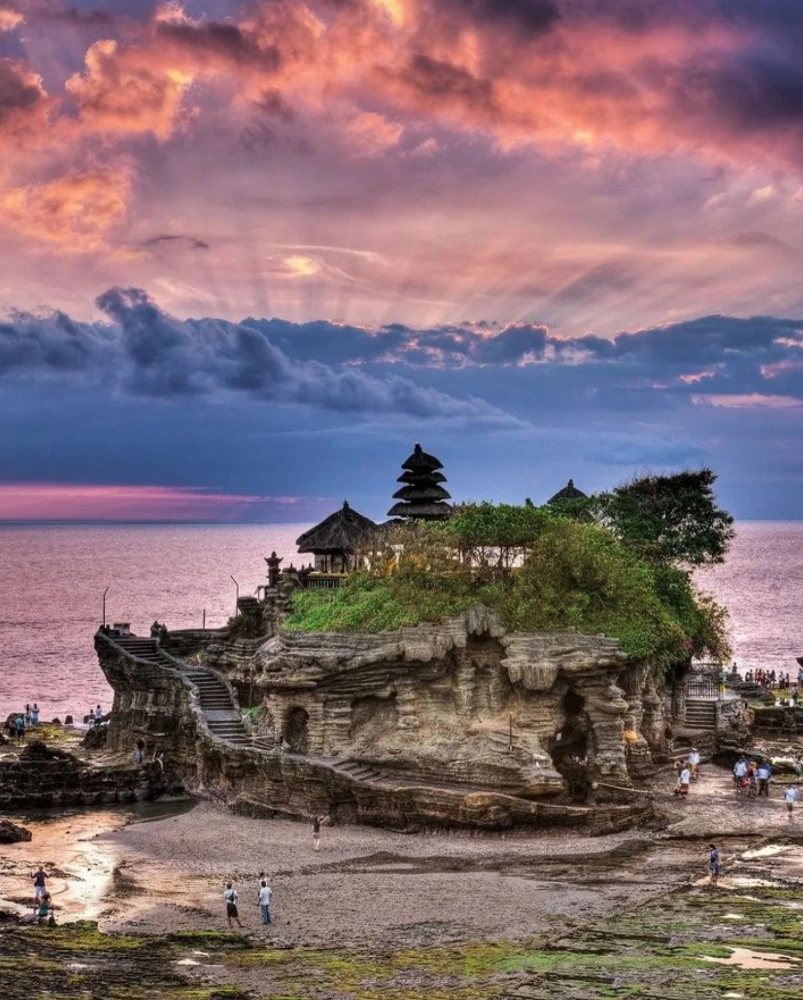
Tanah Lot Temple, or Pura Tanah Lot, is one of Bali’s most iconic and frequently visited sea temples. Here are the key details about Tanah Lot Temple:
- Location and Setting: Tanah Lot Temple is located on the west coast of Bali, in the Beraban village of the Tabanan Regency. It sits on a large offshore rock that has been shaped continuously over the years by the ocean tide.
- Historical and Cultural Significance: The temple is dedicated to the sea gods and is part of a chain of six sea temples spread out along the Balinese coast. According to legend, the temple was founded in the 16th century by the Javanese priest Dang Hyang Nirartha. It is an important pilgrimage site for Balinese Hindus.
- Architecture and Surroundings: The temple’s picturesque setting against the backdrop of the Indian Ocean, especially during sunset, makes it a popular destination for both tourists and photographers. The main shrine is situated on a rock formation that is accessible during low tide. There are several smaller shrines and facilities around the main temple, including souvenir shops and restaurants.
- Sunset Views: Tanah Lot is renowned for its stunning sunset views, which draw large crowds every evening. The silhouette of the temple against the vibrant colors of the setting sun creates a spectacular and memorable sight.
- Tide Considerations: Visitors can walk across the rocky path to the temple during low tide. During high tide, the rock formation becomes an island, and access to the temple is restricted. It’s important to check the tide schedules before visiting.
- Cultural Performances: Tanah Lot also features traditional Balinese cultural performances, such as dance and music, which are often held in the nearby amphitheater.
- Visiting Tips:
- Dress Code: While the temple itself is not open to the public for entry, respectful dress is recommended when visiting the grounds.
- Crowds: Given its popularity, the temple can get crowded, particularly around sunset. Arriving early can help secure a good viewing spot.
- Local Vendors: The area around the temple has numerous stalls selling souvenirs, snacks, and refreshments.
Tanah Lot Temple is celebrated for its unique oceanic setting, spiritual ambiance, and breathtaking sunsets, making it a must-visit destination for anyone traveling to Bali.
Ubud Monkey Forest
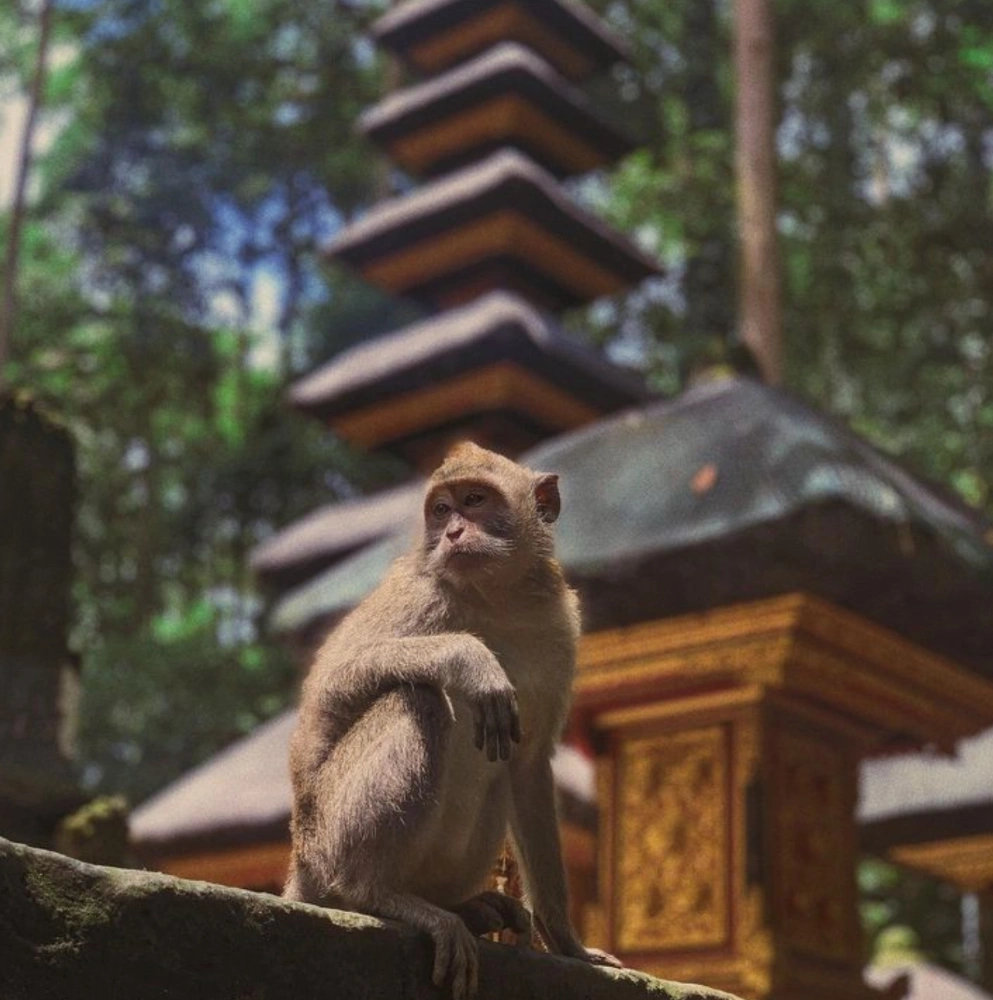
The Ubud Monkey Forest, also known as the Sacred Monkey Forest Sanctuary, is a popular tourist destination and significant cultural site located in Ubud, Bali. Here are the key details about the Ubud Monkey Forest:
- Location: The Ubud Monkey Forest is situated in the village of Padangtegal, Ubud, in the Gianyar Regency of Bali, Indonesia. It is easily accessible from central Ubud and is a well-known attraction in the area.
- Cultural and Spiritual Significance: The forest is not only a natural attraction but also a sacred site for the local community. It houses three ancient Hindu temples: Pura Dalem Agung Padangtegal (the main temple), Pura Beji (a temple dedicated to the goddess Gangga), and Pura Prajapati (a temple for the village’s cremation ceremonies). These temples date back to the 14th century and are still actively used for religious ceremonies.
- Resident Monkeys: The forest is home to over 700 long-tailed macaques (Macaca fascicularis). These monkeys are an integral part of the ecosystem and the cultural landscape. They are generally accustomed to human presence but can be quite mischievous, often interacting with visitors.
- Natural Environment: Covering approximately 12.5 hectares, the Ubud Monkey Forest boasts a lush and diverse landscape. It features dense tropical foliage, ancient banyan trees, and a variety of plant species. The area is also traversed by a river, adding to the forest’s serene and natural ambiance.
- Conservation Efforts: The Sacred Monkey Forest Sanctuary is committed to conservation and research. It aims to maintain the harmony between humans and nature while preserving the forest and its inhabitants. The management also collaborates with various research institutions to study the behavior and health of the monkeys.
- Visitor Experience: Paths and Walkways: The forest has well-maintained paths and walkways, allowing visitors to explore the area comfortably. Interactions with Monkeys: Visitors are advised to keep a safe distance and avoid direct interaction with the monkeys. It is important to secure personal belongings as the monkeys are known to snatch items such as bags, hats, and sunglasses. Feeding Policy: While bananas and other foods are sold nearby for feeding the monkeys, it is recommended to follow the guidelines provided by the sanctuary to ensure the safety of both visitors and the monkeys.
- Tips for Visitors: Dress Appropriately: Wear comfortable clothing and shoes suitable for walking in a forested area. Safety Precautions: Do not bring or display food, and avoid making sudden movements that might startle the monkeys. Respect the Environment: Adhere to posted signs and guidelines to help preserve the natural and cultural integrity of the site.
The Ubud Monkey Forest offers a unique blend of natural beauty, wildlife, and cultural heritage, making it a must-visit destination for those exploring Bali.
Ubud Saraswati Temple
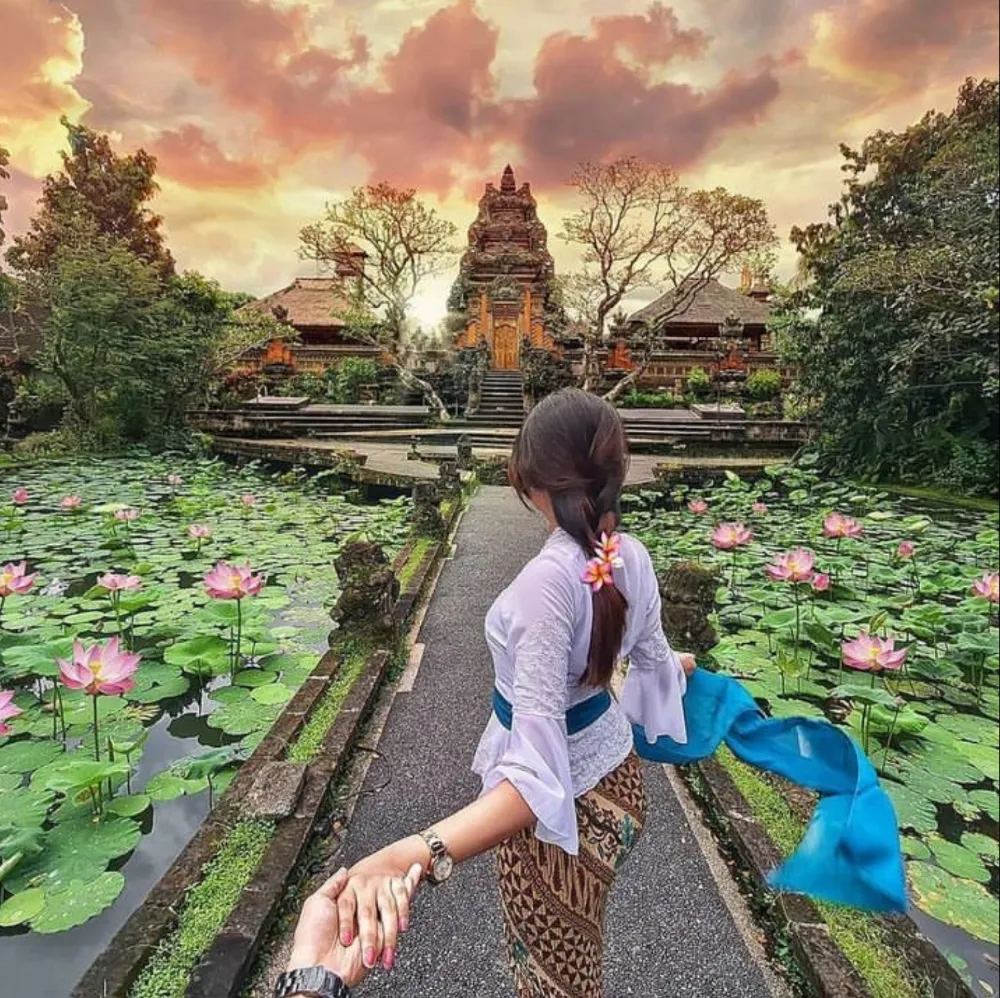
The Ubud Saraswati Temple, also known as Pura Taman Saraswati, is a beautiful Hindu temple in Ubud, Bali, dedicated to Saraswati, the goddess of knowledge, music, art, wisdom, and learning. Here are the key points about this temple:
- Location: Saraswati Temple is located in the heart of Ubud, just off the main road of Jalan Raya Ubud and close to the Ubud Palace. It is conveniently accessible from various points in Ubud, making it a popular stop for visitors exploring the town.
- Architectural Design: The temple is renowned for its stunning Balinese architecture, designed by the famous Balinese architect I Gusti Nyoman Lempad. The temple features intricate carvings, traditional stone statues, and beautiful wooden gates that are typical of Balinese temple architecture.
- Lotus Pond: One of the most striking features of the Saraswati Temple is its large lotus pond. The pond, filled with blooming pink lotus flowers, is flanked by a walkway leading to the temple entrance, creating a picturesque and serene setting that is perfect for photography.
- Cultural Significance: The temple is dedicated to Saraswati, the Hindu goddess of wisdom and the arts. It is an important cultural and spiritual site for the local Balinese Hindu community, who come here to worship and seek blessings from the goddess.
- Traditional Performances: The temple hosts traditional Balinese dance performances, especially in the evening. The most popular is the Kecak dance, which tells the story of the Ramayana through chanting and elaborate choreography. These performances are set against the temple’s beautiful backdrop, adding to the cultural experience for visitors.
- Visiting Tips:
- Dress Code: Visitors are encouraged to wear respectful attire when visiting the temple. Sarongs and sashes are usually available at the entrance if needed.
- Entrance Fee: There is generally no entrance fee to visit the temple itself, but there may be a fee for attending the traditional dance performances.
- Best Time to Visit: The temple is best visited in the early morning or late afternoon to avoid the midday heat and to capture the lotus pond in the best light. Attending an evening dance performance is also highly recommended for a full cultural experience.
The Ubud Saraswati Temple is a must-visit for its exquisite architecture, serene atmosphere, and cultural richness, making it a highlight for anyone exploring Ubud.
Jatiluwih Rice Terrace
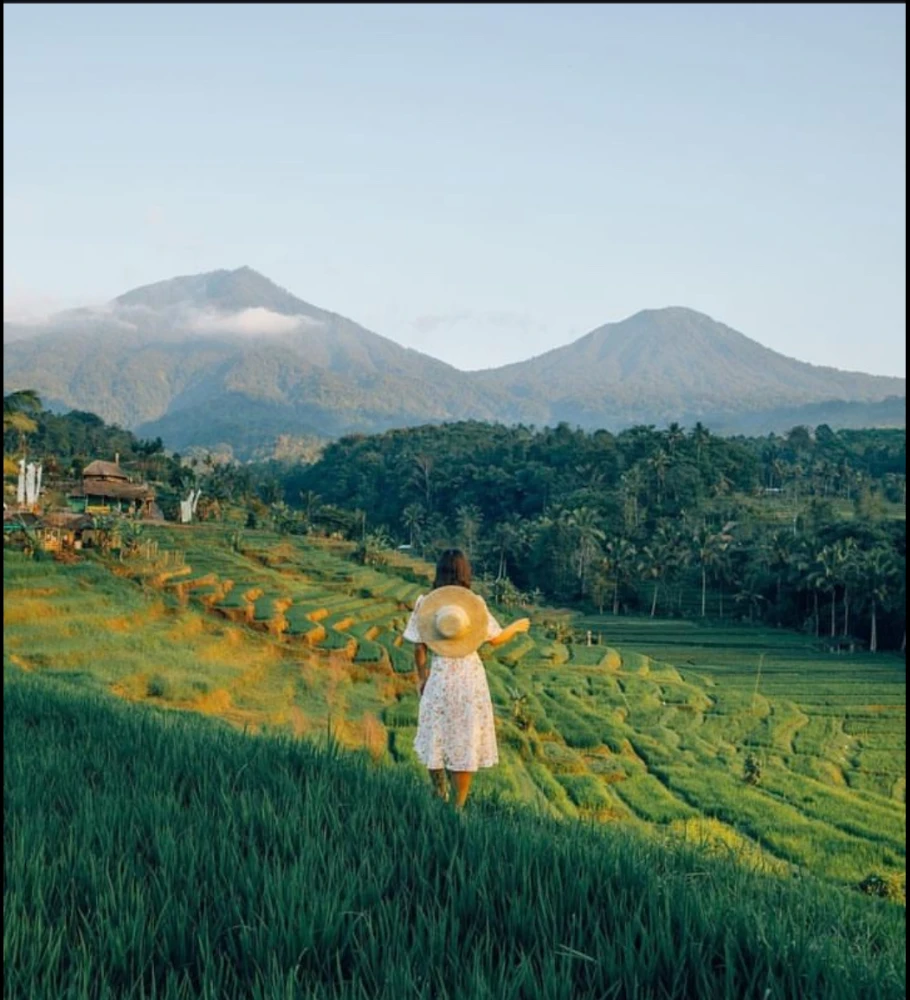
The Jatiluwih Rice Terraces are a UNESCO World Heritage site located in the Tabanan Regency of Bali, Indonesia. They are renowned for their stunning landscapes and traditional agricultural practices. Here are the key details about Jatiluwih Rice Terraces:
- Location: The Jatiluwih Rice Terraces are situated in the central part of Bali, about 700 meters above sea level on the slopes of Mount Batukaru. They are approximately 50 kilometers northwest of Ubud and about 60 kilometers from Denpasar, the capital city of Bali.
- UNESCO World Heritage Site: In 2012, Jatiluwih, along with other sites in Bali, was recognized as a UNESCO World Heritage site under the Cultural Landscape of Bali Province category. This designation acknowledges the traditional subak irrigation system used in the rice terraces, which dates back to the 9th century and reflects the Balinese philosophy of Tri Hita Karana, meaning the harmony between humans, nature, and the gods.
- Scenic Beauty: The Jatiluwih Rice Terraces are famous for their breathtaking beauty, featuring expansive and meticulously maintained rice fields that cascade down the slopes of the hills. The lush greenery and intricate patterns of the terraces make them a popular destination for photographers and nature enthusiasts.
- Traditional Farming Methods: The rice terraces are a living example of sustainable agriculture. The subak system involves a cooperative water management system that ensures equitable water distribution among farmers. This traditional method has been passed down through generations and is integral to the community’s way of life.
- Visitor Experience:
- Hiking Trails: Jatiluwih offers several well-marked hiking trails that allow visitors to explore the rice fields up close. These trails vary in length and difficulty, providing options for both casual walkers and serious hikers.
- Cycling: Bicycling through the terraces is another popular activity, offering a unique way to take in the scenic landscape.
- Guided Tours: Local guides are available to offer insights into the farming practices, history, and cultural significance of the area.
- Best Time to Visit: The best time to visit Jatiluwih is during the rice planting and harvesting seasons, typically from March to May and September to November. During these times, the fields are at their most vibrant. Early morning or late afternoon visits are recommended to avoid the midday heat and to capture the best light for photography.
- Nearby Attractions: The region around Jatiluwih is rich in natural and cultural attractions. Nearby sites include:
- Mount Batukaru: The second highest mountain in Bali, offering hiking opportunities.
- Batukaru Temple (Pura Luhur Batukaru): A significant temple located on the slopes of Mount Batukaru.
- Hot Springs: There are several hot springs in the area, such as the ones at Angseri, offering a relaxing experience after exploring the terraces.
- Dining and Amenities: There are several restaurants and cafes around the Jatiluwih area where visitors can enjoy local Balinese cuisine while taking in panoramic views of the rice terraces. Basic amenities such as restrooms and parking are also available.
Jatiluwih Rice Terraces provide a serene and picturesque glimpse into Bali’s agrarian culture and natural beauty, making them a must-visit for anyone interested in the island’s heritage and landscapes.
Ulundanu Temple
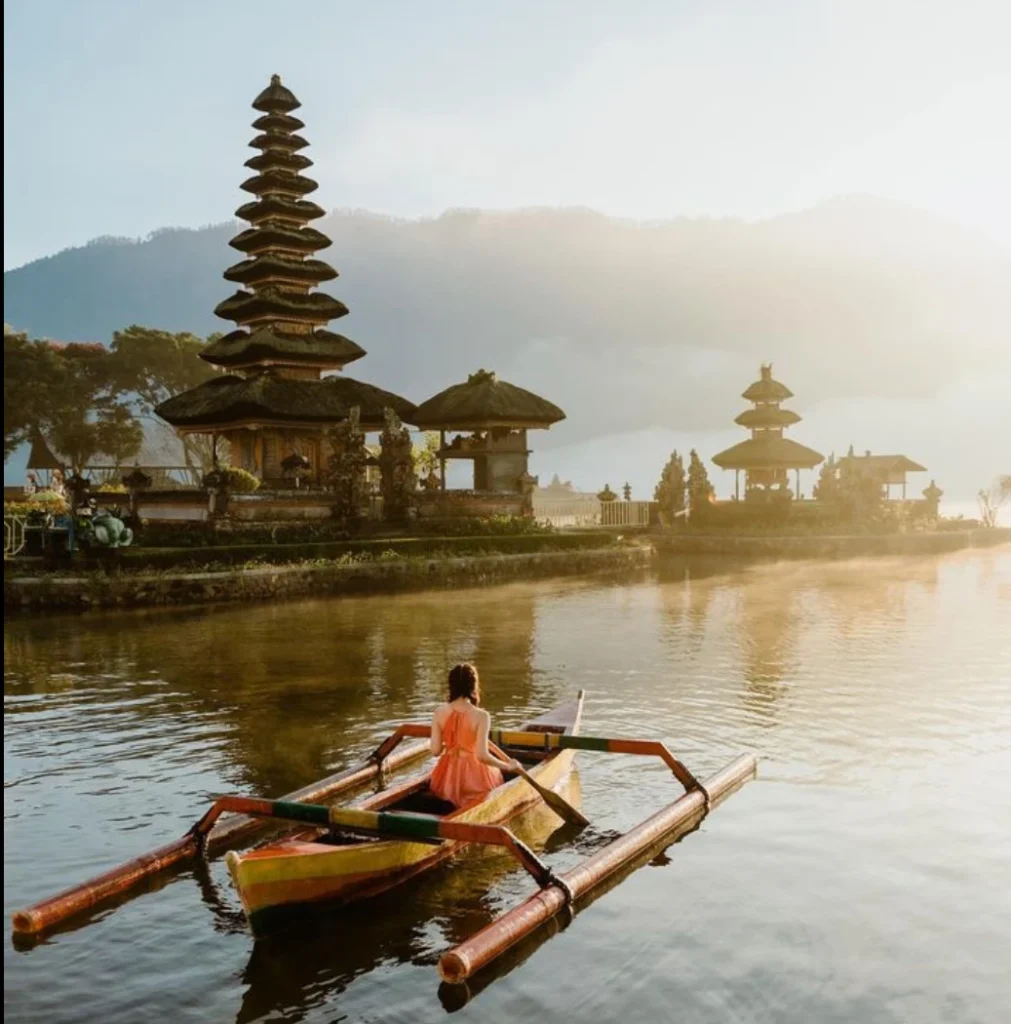
Ulun Danu Beratan Temple, often simply referred to as Ulun Danu Temple, is one of Bali’s most iconic and picturesque temples. Here are the key details about this remarkable site:
- Location: Ulun Danu Beratan Temple is located on the shores of Lake Beratan in the mountainous region of Bedugul, Bali. The temple sits at an elevation of about 1,200 meters above sea level, contributing to its cool climate and misty atmosphere.
- Historical and Cultural Significance: The temple complex was built in the 17th century and is dedicated to Dewi Danu, the Balinese water, lake, and river goddess. It plays a vital role in the irrigation system of the surrounding agricultural area, especially in relation to Lake Beratan, which is a significant water source.
- Architecture and Layout: The temple complex consists of several shrines and merus (multi-tiered shrines) built in traditional Balinese architectural style. The most iconic structure is the 11-tiered meru dedicated to Shiva and Parvati. The temple’s structures are beautifully set against the backdrop of the lake and mountains, often appearing to float on the water when the lake’s water levels rise.
- Scenic Beauty: Ulun Danu Temple is renowned for its stunning setting. The temple complex is surrounded by lush gardens and the serene waters of Lake Beratan, with the surrounding mountains adding to the picturesque scenery. This location provides excellent photo opportunities, especially during sunrise and sunset when the temple is bathed in soft light.
- Religious Practices and Ceremonies: The temple is an active site of worship for the local Balinese Hindu community. It hosts various ceremonies and rituals, particularly those related to water and agriculture, which are essential for the local farmers. Visitors may witness these traditional practices during their visit.
- Visitor Experience:
- Gardens and Grounds: The temple complex is surrounded by well-maintained gardens that feature a variety of local flora. Visitors can stroll through these gardens and enjoy the peaceful environment.
- Boat Rides: Small traditional boats are available for hire, allowing visitors to explore Lake Beratan and view the temple from the water, offering a unique perspective.
- Cultural Displays: Occasionally, cultural performances and traditional Balinese dances are held at the temple, providing insight into local customs and traditions.
- Best Time to Visit: Ulun Danu Temple can be visited year-round, but the best time is during the dry season from April to October when the weather is more predictable. Visiting early in the morning or late in the afternoon helps avoid the crowds and provides the best lighting for photography.
- Nearby Attractions: The Bedugul area offers several other attractions, including:
- Bali Botanic Garden: Located nearby, it is the largest botanic garden in Indonesia and features a wide range of plant species.
- Handara Gate: Famous for its stunning traditional Balinese gate, which has become a popular spot for photography.
- Munduk Waterfall: A scenic waterfall located a short drive away, offering a beautiful natural escape.
- Dining and Amenities: There are several restaurants and cafes around the temple area where visitors can enjoy local Balinese cuisine and international dishes. Facilities such as restrooms and parking are also available.
Ulun Danu Beratan Temple is a must-visit destination in Bali, combining cultural significance, natural beauty, and serene surroundings, making it an unforgettable experience for visitors.
Getting to know more about Hyundai Stargazer automatic transmission

The Hyundai Stargazer is a 2024 model compact MPV that offers a blend of modern design, practicality, and advanced features. Here are the key specifications and features of the Hyundai Stargazer:
Engine and Performance
- Engine: 1.5-liter gasoline engine
- Power: 113 horsepower
- Torque: 144 Nm
- Transmission: Variable Speed Continuously Variable Transmission (CVT)
- Fuel Type: Gasoline
Dimensions
- Seating Capacity: 7 seats
- Overall Length: 4,460 mm
- Overall Width: 1,780 mm
- Overall Height: 1,695 mm
- Wheelbase: 2,780 mm
Interior and Comfort
- Air Conditioning: Yes
- Rear A/C Vents: Yes
- Seats: Adjustable, with options for fabric or leather upholstery depending on the variant
- Infotainment System: Touchscreen display with Apple CarPlay and Android Auto compatibility
- Additional Features: Multi-function steering wheel, digital odometer, and rear reading lamps
Safety Features
- Airbags: Driver and passenger airbags, with additional side and curtain airbags in higher variants
- Anti-lock Braking System (ABS): Yes
- Electronic Brakeforce Distribution (EBD): Yes
- Vehicle Stability Control: Yes
- Child Safety Locks: Yes
- ISOFIX Child Seat Mounts: Yes
- Parking Sensors: Rear parking sensors, with a rearview camera in higher variants
- Hill-Start Assist Control: Yes
Exterior
- Headlights: Adjustable headlights with automatic headlamp features in higher variants
- Alloy Wheels: Standard across variants
- Colors: Available in Creamy White, Dragon Red, Midnight Black, and Magnetic Silver
The Hyundai Stargazer is designed to provide a comfortable and safe driving experience, making it a strong contender in the compact MPV segment. It combines practicality with modern amenities, making it suitable for families and urban commuting.
Getting to know more about Balisakti Bali car rental
Balisakti Bali Car Rental is a well-regarded local car rental company in Bali, known for its customer-focused service and comprehensive vehicle options. We offer a range of vehicles from compact cars to SUVs, catering to various travel needs and group sizes. The rental process is straightforward, with the flexibility of daily, weekly, and monthly rentals, and all vehicles come with insurance coverage for added peace of mind.
Customers have praised Balisakti for their clean and well-maintained cars, as well as the knowledgeable and helpful staff. They provide convenient pick-up and drop-off services, including at Ngurah Rai International Airport, which makes starting your Bali adventure hassle-free, our company is particularly noted for its responsive customer service and our team who often provides valuable local insights and travel tips.
Whether you’re looking to explore Bali’s popular destinations or hidden gems, renting a car from Balisakti allows you to travel at your own pace and convenience, making it an excellent choice for visitors wanting a flexible and comfortable travel experience on the island.
How will you contact and know more about Balisakti Bali car rental
Website : www.balisakti.com
Website : www.balicarrental.biz.id
Phone Number : +6282146554451



